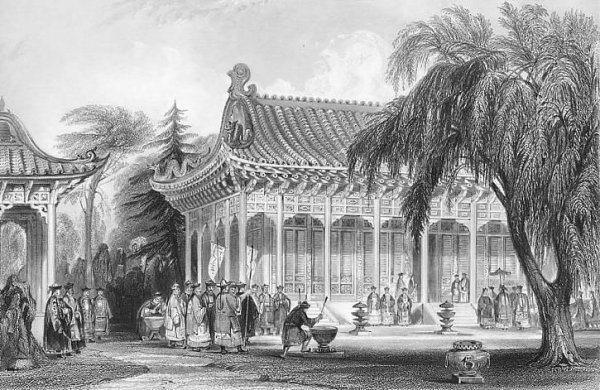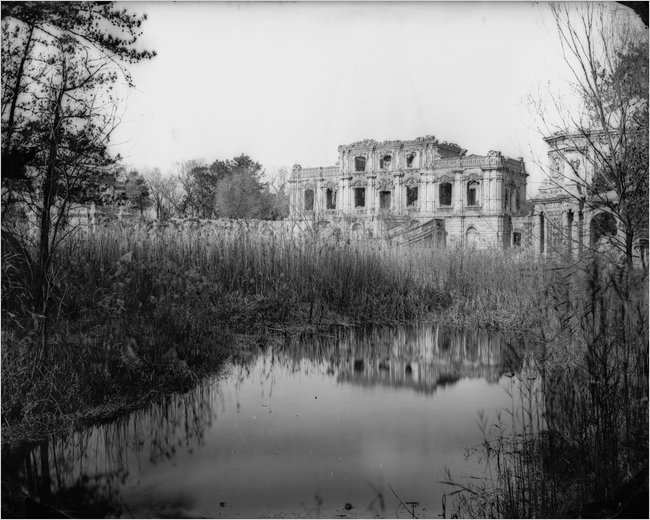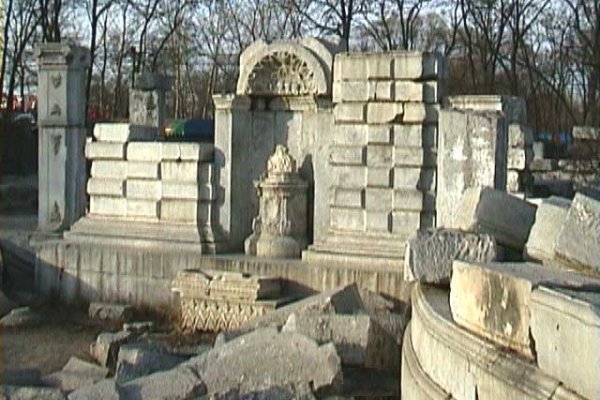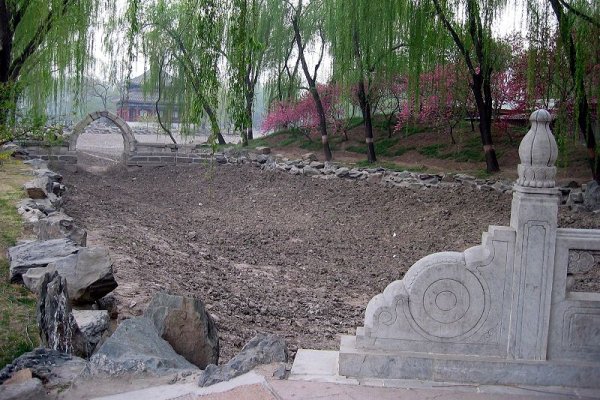Jewish Opium and British Imperialism
The Wanton Destruction of China's Yuanmingyuan
|
China's Yuan Ming Yuan, was almost certainly the
greatest - and most valuable - palace / museum
complex that had existed in the history of the
world. This incredible creation of palaces, gardens
and museums comprised almost 4 square kilometers and
contained more than 10 million priceless and
irreplaceable treasures representing more than 5,000
years of the history of the world's most ancient
civilisation.
It took 150 years to build, and only three weeks to
utterly destroy. The purpose of this article is to
tell that story.
It involves the Jewish Sassoon family, their
exclusive Chinese opium franchise, the British and
French governments, imperialism, greed, and the
wanton, savage and pathological destruction of a
world heritage, on a scale never before seen.
To fully appreciate this story you should read this
background article entitled, "The Jewish Monpoly on
Opium Still Fuels Chinese Resentment Today".
Here is the link.
The Yuan Ming Yuan - 圆明园
|
|

A old painting depicting a portion of the
palaces and gardens. |
The Garden of Perfect Brightness - the great Yuan
Ming Yuan of China - was one of the most magnificent
gardens in the history of the world.
Spanning more than 350 hectares (about 4 square
kilometers), it was a fairyland of hills, ponds,
lakes, ancient trees and palaces.
The Yuan Ming Yuan was considered as one of the
finest examples of Chinese garden landscape ever
created.
Artisans were recruited from all over China to enact
the exquisite Chinese garden settings, the mountain
scenes and the a hundred odd palaces, pavilions and
halls with bridges, pagodas and temples.
A third of the ground was given to nature in the
form of streams, ponds, rockeries, hillocks, cliffs,
ravines and caves. |
|
The
Yuanmingyuan was renowned throughout the world for its
fabled charms and association with Chinese modern history.
Extolled as the "Garden of Gardens" and the "Versailles of
the East" during its heyday, it was an imperial summer
resort painstakingly built and repeatedly expanded under the
personal supervision of five emperors of the Qing Dynasty.
The Yuan Ming Yuan Museum - 圆明园博物馆
But the
Yuan Ming Yuan was much more than just a garden or a
selection of palaces; It was a museum, without question the
largest and most valuable museum the world had ever seen. It
contained more than 10 million artifacts, relics, and
irreplaceable and priceless treasures representing 5,000
years of the world's oldest culture and civilisation.
|

An artist's sketch of a portion of the
Yuamningyuan as it then existed. |
Built during a period of almost 150 years, various
Chinese emperors collected from across the country
the finest samples of all that was precious and
valuable - and irreplaceable - representing all
facets of the country's vast and deep 5,000 years of
history and culture.
Furniture made of red sandalwood, redwood and other
rare materials decorated the numerous halls in which
these countless rare cultural relics were on
display.
Bronze and gold castings were everywhere. Countless
gold castings were destroyed by the British because
they didn't believe so many objects could be made of
real gold.
The French writer Victor Hugo once remarked, "With
all its treasures, Notre Dame in Paris is no match
for Yuanmingyuan, that enormous and magnificent
museum in the East." |
|
It
contained the world's largest collection of artistic
treasures and cultural relics, and an almost unimaginable
imperial library of priceless books, calligraphy and
writings.
As one of the four most famous imperial libraries, the
Wenyuan Hall (Hall of Literary Profundity) in the garden
originally housed such precious ancient books as The
Complete Library of Four Branches of Books (《四库全书》), Gems of
the Complete Library of Four Branches of Books (《四库全书荟要》),
and The Completed Collection of Graphs and Writings of
Ancient and Modern Times (《古今图书集成》).
The Yuan Ming Yuan Administrative Residence - 圆明园行政公寓
For
almost 150 years, Yuan Ming Yuan served for China's
government administration, vacation and residences for six
generations of emperors in the Qing dynasty. The emperor and
his wives would live in Yuan Ming Yuan after Chinese New
Year until the end of autumn. It was the summer retreat and
sometimes main residence of Qing emperors.
Opium, Misery, Profit and War - 鸦片,苦难,利润和战争
|

Another artist's sketch of the front
entrance
to the Yuamningyuan. |
The Sassoon's opium franchise was totally supported
by the full might of the world's greatest military -
that of the British Empire.
As a result, China's very social fabric was being
slowly eviscerated, the economy being destroyed, the
country's financial reserves disappearing, the
nation becoming weaker.
Naturally, the Chinese began fighting back, but the
British government and the Jewish families who
controlled the fantastically profitable opium trade
were not to be easily discouraged.
During one period of resistance in 1856, the Chinese
seized some ships, threw the opium cargo into the
rivers, arrested and killed some of the crew. The
Sassoons demanded retaliation and compensation for
their loss. |
|
To
accommodate them, Britain falsely claimed the ships and
cargo to be British, and commenced military reprisals
against China. However, it is generally believed that the
British used these events as a pretext for already-planned
military action intended to make China more pliable to
commercial penetration and more amenable to an intended
colonial partition of the country.
Flames of the Yuan Ming Yuan - 火烧圆明园
In
August 1860, English and French forces under the command of
Generals Hope Grant and Cousin-Montauban, invaded the
undefended Yuanming Yuan and began looting the palaces and
museums. There followed an orgy of indiscriminate plunder
and destruction, continuing until both French and British
felt they could carry no more. Anything that could not be
carted off was ordered destroyed.
Lord Elgin, the British commander-in-chief, ordered that, as
a final blow and act of ultimate revenge, the now-looted
Yuan Ming Yuan should be set on fire and destroyed. This was
the son of the Lord Elgin who looted the marble friezes from
Greece’s Parthenon.
|

This photo taken by Ernst Ohlmer in 1873 is
believed to be one of the earliest photos of the
Yuamningyuan. |
"The British calculated that the destruction would
break the Chinese emperor’s will to resist, and they
seem to have been right.
China surrendered the same day and signed the
disadvantageous Convention of Peking, which among
other things opened more Chinese ports for
international commerce and legalized the opium
trade."
The French claim to have objected to this
destruction, but firm evidence supporting this
position appears to be lacking.
In any case, the French participated quite fully in
the ensuing cultural atrocities, being quite willing
not only to take their share of the "prizes" but to
destroy what they couldn't steal.
Everything that remained, all treasures, artifacts,
books, cultural relics, that could not be looted
were deliberately destroyed.
|
|
Everything was smashed, broken and ruined. Then all the
buildings were set aflame, with fires that burned for days,
with such a volume of smoke that on occasion it appeared all
of Beijing was in flames.
Because the Yuanmingyuan was so vast - roughly five times
the size of Beijing’s Forbidden City and eight times that of
the Vatican City - it took an entire infantry division of
nearly 4,500 men, including four British regiments and the
15th Punjabis, to set it aflame. |

A photo of some of the ruins of the
Yuamningyuan today.
Only some carved stone rubble survives. |
In total, it took more than 7,500 soldiers more than
three weeks to wantonly and unforgivably destroy and
burn to the ground the greatest concentration of
cultural treasures that had ever existed in the
history of the world.
"Gilded beams crashed, porcelain roofs buckled, ash
filled the lakes and embers snowed down on Beijing,
where clouds of dense smoke eclipsed the sun.
Upon hearing the news, the ailing 30-year-old
Xianfeng emperor vomited blood; less than a year
later he was dead."
"It was a sacrifice of all that was most ancient and
most beautiful,” acknowledged Robert McGhee,
chaplain to the British forces and a participant in,
and defender of, the destruction. “It is gone, but I
do not know how to tear myself from it." |
|
"“I
love to linger over the recollection, but I cannot make you
see it,” he wrote. “A man must be a poet, a painter, a
historian, a virtuoso, a Chinese scholar, and I don’t know
how many other things besides, to give you even an idea of
it, and I am not an approach to any one of them. But
whenever I think of beauty and taste, of skill and
antiquity, while I live, I shall see before my mind’s eye
some scene from those grounds, those palaces."
But it was Profitable - 但它是盈利的
|

Another photo of the Yuamningyuan ruins as
they are today. |
It is finally even more painful and outrageous to
realise that this accumulation of 5,000 years of
culture was deliberately plundered and razed to the
ground as a kind of "punishment", to mellow a
colonial victim into submission.
And it was done by the English and French forces
primarily to protect the "business" interests of the
Jewish Sassoon family in their unconscionable
crusade to destroy an entire ancient civilisation of
people with an addictive drug - for the sake of
their personal wealth.
But for the Sassoons, it was worth the effort.
They became the richest family in the world at the
time, second only to the Rothschilds themselves.
By the 1860s, the Sassoons were multi-billionnaires. |
|
The
stories we hear today of Bill Gates or Warren Buffett being
"the richest man in the world" are just urban legends for
the naive. The Rothschilds, the Sassoons, and similar
families today are each worth an estimated 6 trillion to 7
trillion dollars. Wars and human devastation were the source
of their wealth.
China will never forget - 中国永远不会忘记
A
century and a half later, the Yuanmingyuan holds a similar
grip on the China that has inherited its ruins and can
forget neither its vanished glory nor its vindictive
desecration. Ultimately, a loss as great as that of the
Yuanmingyuan may be one with which China will never come to
terms.

The Yuamningyuan lake, drained of its water
and
the grounds bereft of life and beauty. |
"The Yuanmingyuan is the shame in the heart of the
Chinese people," said Que Weimin, a professor at the
World Heritage Research Center at Peking University.
"And it's a reminder for the whole world that such
destruction of human cultural heritage should not
happen again."
Anyone who appreciates beauty and human enterprise
will be outraged when they visit the present
YuanMingYuan.
In a Chinese museum today is a copy of a letter
written in 1861 by Victor Hugo condemning the
destruction by the invading Anglo-French troops as
barbaric.
It is painful to see the ruins and think that this
once beautiful imperial park with its exquisite
gardens, Chinese palaces and Western Baroque
buildings, contained millions of art treasures and
cultural relics and an imperial library of
irreplaceable books. |
|
Under the order of Premier Zhou Enlai, the Yuan Ming
Yuan became a park to remind the Chinese and the
world of the destruction wrought by European
colonial powers to a harmless and priceless cultural
entity that rightly belongs to mankind.
It was a tragedy that the Yuan Ming Yuan took so
many years to raise to glory but only a few days of
wanton destruction in 1860 to obliterate. Such was a
painful waste for humanity, this fruit of man’s
ingenuity, conceived as a Garden of all Chinese
Gardens.
But this wasn't the end. Again, in 1900, the allied
forces of the Eight Powers invaded Beijing and
sacked the remaining buildings in the park. Many
priceless artifacts that were plundered made their
ways to the museums and private collections in
Europe - where they still remain.
England and France have yet to apologise for this
atrocity, or indeed to even admit that it occurred.
|
| |
Bibliography
By SHEILA MELVIN in the New York Times; October 21,
2010
http://www.nytimes.com/2010/10/22/arts/22iht-MELVIN.html?_r=2&ref;=china
http://en.beijing2008.cn/spectators/beijing/tourism/list/n214068425.shtml
Kutcher, Norman. 2003. “China’s place of memory,”
Wilson Quarterly 27(1), 30-40.
http://www.stanford.edu/group/chr/drupal/ref/1860-sack-of-yuanming-yuan
Wolseley, Garnet. 1862. Narrative of the War with
China in 1860. London: Longman, Green, Longman &
Robert.
(Available at
http://ringmar.net/europeanfury/?page_id=1159).
http://www.chinapage.com/friend/goh/beijing/yuanmingyuan/yuanmingyuan.html
|
|









































